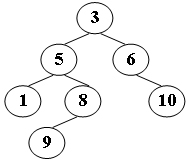Level-order Traversal(c语言函数指针样例)
Write a routine to list out the nodes of a binary tree in “level-order”. List the root, then nodes at depth 1, followed by nodes at depth 2, and so on. You must do this in linear time.
Format of functions:
void Level_order ( Tree T, void (*visit)(Tree ThisNode) );where void (*visit)(Tree ThisNode) is a function that handles ThisNode being visited by Level_order, and Tree is defined as the following:
typedef struct TreeNode *Tree;
struct TreeNode {
ElementType Element;
Tree Left;
Tree Right;
};Sample program of judge:
#include <stdio.h>
#include <stdlib.h>
#define MaxTree 10 /* maximum number of nodes in a tree */
typedef int ElementType;
typedef struct TreeNode *Tree;
struct TreeNode {
ElementType Element;
Tree Left;
Tree Right;
};
Tree BuildTree(); /* details omitted */
void PrintNode( Tree NodePtr )
{
printf(" %d", NodePtr->Element);
}
void Level_order ( Tree T, void (*visit)(Tree ThisNode) );
int main()
{
Tree T = BuildTree();
printf("Level-order:");
Level_order(T, PrintNode);
return 0;
}
/* Your function will be put here */Sample Output (for the tree shown in the figure):
Level-order: 3 5 6 1 8 10 9代码:
void Level_order ( Tree BT,void (*visit)(Tree ThisNode))
{
if(BT == NULL)return;
struct TreeNode *queue[100];
int head,tail;
head = tail = 0;
queue[tail++] = BT;
while(head!=tail)
{
(*visit)(queue[head]);
if(queue[head]->Left!=NULL)queue[tail++] = queue[head]->Left;
if(queue[head]->Right!=NULL)queue[tail++] = queue[head]->Right;
head++;
}
}


